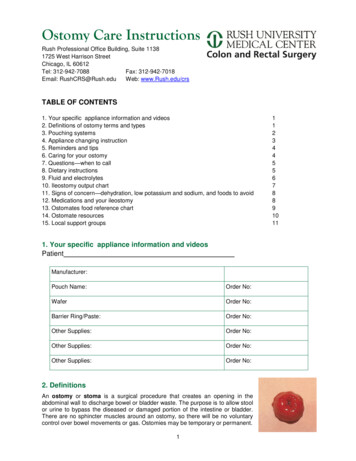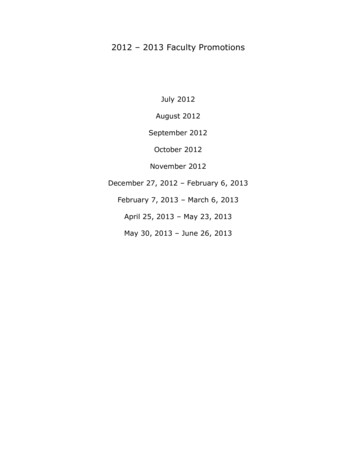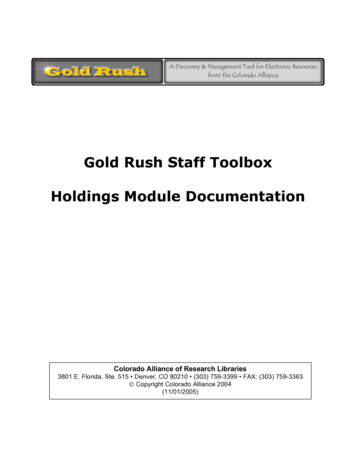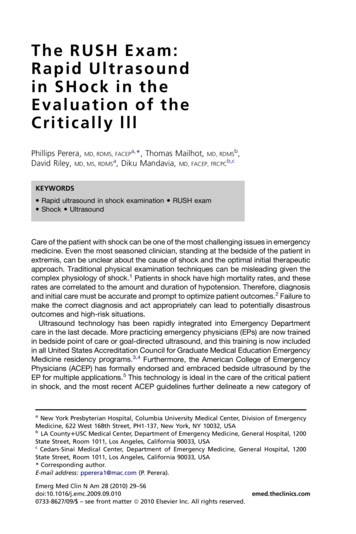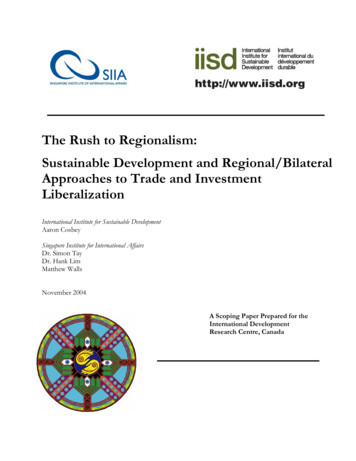
Transcription
The Rush to Regionalism:Sustainable Development and Regional/BilateralApproaches to Trade and InvestmentLiberalizationInternational Institute for Sustainable DevelopmentAaron CosbeySingapore Institute for International AffairsDr. Simon TayDr. Hank LimMatthew WallsNovember 2004A Scoping Paper Prepared for theInternational DevelopmentResearch Centre, Canada
2005 International Institute for Sustainable Development (IISD) and International DevelopmentResearch Centre (IDRC)Published by the International Institute for Sustainable DevelopmentThe International Institute for Sustainable Development contributes to sustainabledevelopment by advancing policy recommendations on international trade and investment,economic policy, climate change, measurement and assessment, and naturalresources management. Through the Internet, we report on international negotiationsand share knowledge gained through collaborative projects with global partners, resultingin more rigorous research, capacity building in developing countries and better dialoguebetween North and South.IISD’s vision is better living for all—sustainably; its mission is to champion innovation,enabling societies to live sustainably. IISD receives core operating support from theGovernment of Canada, provided through the Canadian International DevelopmentAgency (CIDA) and Environment Canada; and from the Province of Manitoba. Theinstitute receives project funding from numerous governments inside and outsideCanada, United Nations agencies, foundations and the private sector. IISD is registeredas a charitable organization in Canada and has 501(c)(3) status in the United States.International Institute for Sustainable Development161 Portage Avenue East, 6th FloorWinnipeg, ManitobaCanada R3B 0Y4Tel: 1 (204) 958-7700Fax: 1 (204) 958-7710E-mail: info@iisd.caWeb site: http://www.iisd.org/
Table of Contents1. Introduction . 12. Trends in Regionalism . 23. A Survey of Actual Practice. 53.1 Development aspects of the agreements. 63.2 Environmental aspects of the agreements . 93.2.1 Environment and sustainable development as objectives of the agreement. 93.2.2 Environmental exceptions. 113.2.3. MEAs and trade law . 123.2.4. Environmental impact assessment . 123.2.5. Regulatory impacts: services and investment . 133.2.6. Environmental governance . 164. Issues for Consideration .214.1. Why the rush to regionalism?. 214.1.1. Economic considerations . 224.1.2. Strategic considerations . 234.2. Does the rush to regionalism undermine the multilateral system?. 254.3. The impacts of level of development on FTA characteristics . 284.3.1. North-North agreements . 284.3.2. North-South agreements. 284.3.3. South-South agreements. 294.4. Regionalism and sustainable development. 304.4.1. Economic implications. 314.4.2. Environment and development implications . 334.5. The role of business and the market. 365. Scope for Improvement . 376. State of Research. 387. References.41
1. IntroductionThe unmistakable signs of a rush to regionalism in investment and trade agreements are all aroundus. It seems that not a week goes by that some pair or group of countries do not announce theirintent to negotiate a new agreement. This is in stark contrast to the state of affairs ten years ago,when NAFTA was the first North-South free trade agreement (FTA) to be signed, and most of theSouth-South agreements existed in name only – grand hopes gradually gone flat.The trend to economic regionalism poses a number of questions from a sustainable developmentperspective, and the rate of negotiation makes those questions urgent. The most basic is to identifythe impetus for the new trend. Why the rush to regional and bilateral agreements? Why nowinstead of ten years ago? Understanding the underlying dynamic is more than a theoreticalpromenade. It may, among other things, help us to better understand how to influence theoutcomes.The next set of questions relates to the import of the trend. What exactly does this fundamentalshift mean for sustainable development? There are a number of topics subsumed in this broadquestion:¾ What does the trend to regionalism mean for the multilateral trading system? If it implies aweakening of the MTS, what are the development implications for the various groupings ofdeveloping countries?¾ Beyond the well-worn but important question of trade creation vs. trade diversion, whichapplies essentially to market access provisions, what are the implications of the rules-basedelements of the current crop of agreements (investment, IPRs, competition policy, tradefacilitation, etc.)?¾ Are countries using FTAs as they were used in the past, to strategically advance theirobjectives at the multilateral level? This question has specific salience for the new crop ofsouth-south agreements.¾ How do the new agreements address the trade-environment relationship? How do theymeasure up to past practice?¾ Are there distinct characteristics to North-North, North-South and South-Southagreements?¾ Is cooperation on environmental issues better served by a regional focus? If so, are thecurrent agreements (here the scope will include analyzing trade-related environmental sideagreements such as the NAAEC) fully exploiting this potential?This paper aims to set out the issues of importance in addressing the links between sustainabledevelopment and the rush to regionalism. It begins by describing the trends in regional agreements.It then surveys current practice, asking how the agreements address a number of key issues ofimportance to sustainable development, both in the context of economic development and thecontext of environment. Based on that survey, and a survey of the literature, it then sets out anumber of key themes, and asks what we know and do not know about each. The concludingsection describes the state of research in relation to these themes.A note on terminology is needed at the outset. Regional and bilateral trade and investmentagreements go by many different names, depending on the analyst. Those who find them a threat toThe Rush to Regionalism: Sustainable Development and Regional/Bilateral Approaches to Trade and Investment Liberalization1
the multilateral trading system prefer the title Preferential Trade Agreements. Others, primarily theWorld Bank, prefer Regional Integration Agreements. In this paper we use the term Free TradeAgreements, but do so in the full knowledge that, in the first place, they involve much more thantrade in goods or services and that, in the second place, they may not in all cases be forces forunblemished liberalization. Often in the paper we explicitly broaden the definition of FTAs toinclude bilateral investment treaties (BITs), though the main focus of the analysis is broader tradeagreements.2. Trends in RegionalismRegionalism in trade and investment agreements has been on a steep rise since the early 1990s. Thenumber of agreements under negotiation or under consideration is for all intents and purposesincalculable, changing on a weekly basis. Of the 273 regional trade agreements that had beennotified to the WTO as of December 2003, only 120 pre-date 1995. If planned agreementsconclude as planned under WTO notification, the end of 2005 will see almost 300 regional tradeagreements in force.1Some scholars have identified this recent phenomenon as the “second wave” of regionalism, thefirst wave having occurred in the 1960s and 1970s. There are some similarities and differencesbetween the two waves. It has been noted that the first wave consisted more of regional tradearrangements, but the second wave has led to a proliferation of bilateral trade agreements. As well,the first wave generated tariff reductions as the main objective of trade agreements but the recentwave of agreements between countries have included areas of economic cooperation beyond tariffreduction and many governments have adopted a multi-tracked approach to trade liberalization.This is best exemplified by the US and South-East Asian strategies of “competitive liberalization” inwhich regional and bilateral trade negotiations are seen as helping to drive the multilateral agendawith greater effectiveness.Recent trade agreements have generally been of two kinds, either a straightforward trade agreementor a trade agreement as part of a broader economic partnership agreement involving tradefacilitation cooperation, labour and/or environmental cooperation along with a FTA. Often theirsignatories describe them as “a new benchmark,” “comprehensive,” or “new age.”. Theseagreements tackle issues—investment, government procurement, environment, competition policy,intellectual property rights—that are still under negotiation at the WTO, or have been dropped fromnegotiations until after the Doha round.Since East Asian countries were among the last to pursue bilaterals, only a handful of agreementshave been signed there to date. Dozens, however, have been proposed, including one, commonlyknown as the East Asia FTA, which would encompass North and Southeast Asia and would be oneof the largest free trade areas in the world. Among the most significant of those signed, on accountof their complexity, depth and the size and development level of the economies involved, are theUSSFTA, the ASEAN FTA (AFTA),2 the Republic of Korea-Chile FTA, the JSEPA, the ASEAN1Information taken from the WTO web site as of October 12, 2004.http://www.wto.org/english/tratop e/region e/region e.htm, and from WTO (2003a).2This November at the 10th ASEAN Summit, ASEAN countries will sign a framework agreement to implement theASEAN Economic Community (AEC), which will subsume within it AFTA, the ASEAN Agreement on ServicesThe Rush to Regionalism: Sustainable Development and Regional/Bilateral Approaches to Trade and Investment Liberalization2
China Comprehensive Economic Partnership Agreement (ACFTA) and the Australia-ThailandCloser Economic Relations FTA (TAFTA).The US has been energetic in signing bilateral and regional trade agreements in recent years,concluding agreements with Singapore and Chile (2003), and Australia, Bahrain, Morocco and thefive Central American states & Dominican Republic (2004). It is currently negotiating with the fourAndean nations, and the five countries of the South African Customs Union (SACU) and Panama.It is also pursuing what it calls the Enterprise for ASEAN initiative, aiming to conclude bilateraltrade deals with the Association’s ten-members.3 Similarly it is pursuing a Middle East Free TradeArea Initiative, aiming at bilateral investment treaties and free trade agreements with a number ofcountries. It has signed Trade and Investment Framework Agreements (TIFAs)—prerequisites toBITs and FTAs—with seven Middle Eastern countries. And it is in negotiations with the 34countries of the western hemisphere (minus Cuba) on a Free Trade Area of the Americas.The EU is also pursuing a number of regional initiatives. In 2004 it completed the accession processwith 10 new members, is negotiating on four additional candidate countries and is pursuing specialintegration status for six Balkan states. Under the wider cooperative framework of the “BarcelonaProcess” it is pursuing a Euro-Mediterranean free trade area by 2010, and has signed bilateralAssociation Agreements with 11 of the 12 countries involved. Its long-standing preferentialrelationship with the African and Caribbean countries is currently undergoing a fundamental changewith the negotiation of Economic Partnership Agreements with six regions. It is also negotiating afree trade agreement with the six states of the Gulf Cooperation Council, and with the four states ofMercosur – the common market of the Southern Cone.This frenetic pace of activity is reflected in the rest of the world as well, as countries in South Asia,the Persian Gulf, Latin America and Africa negotiate integration and cooperation agreements orenter into talks aimed at eventually doing so.Most of these agreements explicitly recognize in their texts GATT Article XXIV and GATS ArticleV, which are known as the WTO’s preferential trade agreement exception articles. The WTO allowsfor FTAs provided they meet these three criteria: trade barriers with non-signatories are not raised,the free trade area should be fully established within a reasonable transition period, generallyinterpreted as no more than ten years, and lastly, the tariffs and regulations should be eliminated for“substantially all sectors.” The latter has been subject to various interpretations, with some debatingwhether ‘substantial’ should mean sheer trade volume or the most significant traded products.4 Theagreements under discussion lean towards ‘significant;’ by its subjective nature, it allows countriesgreater freedom for protectionism.Precedent here is of great importance. Korea, for instance, which has a strong farm lobby, was urgedby some of its academics to learn from NAFTA and the EU-Mexico FTAs, the one which excluded(AFAS) and the ASEAN Investment Area (AIA). The AEC was launched at the 2003 ASEAN Summit, as the thirdpillar in the ASEAN Community. The ASEAN Security Community and ASEAN Socio-cultural Community are theother two pillars.3As noted, an agreement with Singapore is already concluded, and Thailand is in negotiations. As of October 2004the US has completed trade and investment framework agreements (TIFAs)—a prerequisite to a trade agreement—with Indonesia, Philippines, Thailand, Brunei Darussalam and Malaysia.4See Matsushita (2004), Davey (2003), Trachtman (2002).The Rush to Regionalism: Sustainable Development and Regional/Bilateral Approaches to Trade and Investment Liberalization3
domestic agricultural support and the other which ended up covering only 64 per cent of EUagricultural goods.5 In its defense, the EU claimed its FTA met the conditions of Article XXIV sinceagriculture was a small share of their bilateral trade; Korea in its FTA did the same.6 It managed toexclude twenty agricultural products, including rice, while postponing negotiation on 337 agriculturaltariff lines until after the DDA.7 Chile, which originally demanded complete agriculturalliberalization, in turn asked that refrigerators and washing machines be left off its tariff schedule.Japan, in its negotiations with Mexico, had also been advised to negotiate for the same commitmentsthe EU made in its agriculture and fisheries sectors in the EU-Mexico FTA.8Given that the definition of ‘substantial’ has been stretched and that it has not yet been defined atthe WTO level, it is difficult to categorically state that all the agreements under discussion satisfy thiscriterion. The need for consensus makes this virtually impossible anyhow if it is to discipline anyspecific agreement some members may have concluded. However, most of the agreements thathave been recently signed do not significantly modify the rights and obligations existing under themultilateral system of trade. As shown below, with only a few exceptions the agreements areconsistent with the existing WTO rights and obligations. Sectors that are under negotiation, such asagriculture and services, have typically been excluded from discussions, or included but limited tospecific goods. And in those sectors that have not yet been discussed at the multilateral level, such ascompetition policy and investment (with only a weak multilateral agreement), precedents have beenset that do not conflict with the WTO agreements, but nevertheless mark a significant break withthe status quo.The path being laid out in East Asia and elsewhere seems to be the one predicted by mosteconomists who have argued that sensitive sectors would be excluded, or left at current WTObound levels in FTAs, and would hence increase the likelihood of trade diversion. This especiallyseems the case in the liberalization in agriculture. Subsidies are generally not discussed at all, and theexceptions are telling: the US-Australia FTA, for example, prohibits export subsidies, which neitherParty uses, but says nothing about the many other forms of domestic support used extensively bythe Parties. As well, the tariff schedules for some products stretch over decades, dropping over timein small increments. In the Thailand-Australia FTA, for instance, Thailand’s dairy sector does notbecome duty-free until 2025. However, as Thailand is a developing country, this is not a surprise.ASEAN has given its newest members—Cambodia, Laos, Myanmar and Vietnam—tariff deadlinesdepending upon their entrance date and level of development. The three latter countries will be thelast to achieve zero tariff levels, in 2018.One notable exception, however, is the ASEAN-China Comprehensive Economic Partnershipagreement. A framework agreement was signed in November 2003 and negotiations on the goodssector should have been concluded in July 2004 (a notification of extension has been served). Thisagreement will have an innovative feature similar to special and differential treatment in the WTO.The ‘Early Harvest Schedule’ will give ASEAN’s developing countries preferential access on(mostly) agricultural goods. These countries do not have to reciprocate China’s offer until a futuredate yet to be negotiated. Most observers believe that this is mostly a political gesture by China to5See Kim S-Y (2002), Scollay (2003).Kim S-Y(2002).7Kim, Y-K (2002).8Shoji and Hosano (2003).6The Rush to Regionalism: Sustainable Development and Regional/Bilateral Approaches to Trade and Investment Liberalization4
demonstrate that its economic growth will be beneficial for the region, and to establish itself as theregion’s leader.9Other cases, however, tend to prove the rule: both the EU-Mercosur negotiations and the FTAAnegotiations are, as of October 2004, faltering badly or stalled, having failed to overcome difficultiesrelated to sensitive issues. In the case of EU-Mercosur these relate almost entirely to market accessfor Mercosur’s agricultural products. In the case of the FTAA, the problem is again agriculture—including the issue of US market access and domestic support—as well as Brazil’s sensitivity to talkson investment.Protectionism is not limited to specific sectors but can also be seen at the country level. The moreopen economies, such as the U.S., Canada and Australia, have signed more comprehensiveagreements that go beyond current WTO commitments. Japan and Korea, meanwhile, both knownas more protectionist economies, have been very reluctant to agree to deep and broad liberalizationcuts in their sensitive sectors. In the JSEPA, Japan achieved very strict rules of origin—60 per cent.It also excluded its construction industry from the government procurement chapter,10 governmentprocurement from its investment chapter, and pushed Singapore to agree that voluntary standardswould not be subject to the FTA. And while both Japan and Singapore established a JointCommittee for Mutual Recognition, whose work would be to approve certification bodies, a finalclause is included that gives either country the right not to recognize the other country’s standards.113. A Survey of Actual PracticeThis section will survey a number of existing FTAs, analyzing how they address and effect issuesimportant to environmental protection, and economic and social development in the regionscovered. The results of this original survey, coupled with a survey of the literature, will provide afoundation for the next section, which will try to outline the major implications of the rush toregionalism for sustainable development.The agreements surveyed in this section include:Association of South-East Asian Nations (ASEAN)ASEAN Free Trade Agreement (AFTA)ASEAN-China Comprehensive Economic Partnership AgreementASEAN-Japan CEPAustralia-Thailand Closer Economic Relations FTACanada-Chile FTACanada-Costa Rica FTACotonou Partnership AgreementEuro-Med Agreements (using Egypt as an example)European Union (EU)Japan-Singapore Economic Partnership Agreement (JSEPA)Korea-Chile FTA9See for example, Soesastro (2004), Cheow (2004).Construction services are also excluded in the government procurement chapters of the USSFTA.11Kim Y-K (2002).10The Rush to Regionalism: Sustainable Development and Regional/Bilateral Approaches to Trade and Investment Liberalization5
Korea-China FTANorth American Free Trade Agreement (NAFTA)Panama-Taiwan FTASingapore-Australia FTASouth Asian Free Trade Agreement (SAFTA)US-Australia FTAUS-Bahrain FTAUS-Central American States (and Dominican Republic) FTA (CAFTA)US-Chile FTAUS-Jordan FTAUS-Morocco FTAUS-Singapore FTA (USSFTA)3.1Development aspects of the agreementsSection 4, below, will consider the economic impacts of FTAs, revisiting a number of well-wornarguments for and against FTAs in that context. This section will ask how the current crop of FTAstreats a number of issues that are important for countries’ development prospects. Those issuesinclude:¾¾¾¾¾¾Investment rulesIntellectual property rightsCapital controlsTrade in servicesDispute settlement mechanismsInstitutions of development cooperationAll of these issues tend to be treated differently by the different agreements, in line with thepreferences of the Parties. The recent US agreements go well beyond the WTO commitments in theareas of investment, and also in another area of deeper integration: intellectual property rights. Oninvestment, following the precedent set by NAFTA, the US agreements contain binding obligationson non-discriminatory treatment (both pre-and post-establishment), on expropriation, on minimumstandards of treatment and on limits to the use of performance requirements. The latter obligationis the only one contained in the WTO’s TRIMS Agreement. Also, in another developmentpioneered by NAFTA, the agreements contain a mechanism whereby investors may directly impel astate to enter into arbitration where a breach of obligations is alleged. As the next section describes,the majority of modern FTAs follow this pattern of going beyond the WTO rules on investment.On intellectual property rights, all the US agreements starting with NAFTA create a wide range ofWTO-plus obligations. The final provisions vary from agreement to agreement. For example theUSSFTA (Art. 16.8), like the US agreements that come after it, protects the safety testing data frompharmaceuticals (whether patented or not) for five years, in effect meaning generic drugs producedduring that time must do their own testing before gaining approval. Given the costs of safetytesting, this is a significant requirement, and in effect grants a five year protection from genericcompetition that is not granted in TRIPs. The US-Morocco FTA (Art. 15.9.2) contains obligationsto register patents on existing drugs if “new use” for those drugs is found. This practice, called“evergreening,” is used by patent holders to extend the life of their patent protection beyond thatThe Rush to Regionalism: Sustainable Development and Regional/Bilateral Approaches to Trade and Investment Liberalization6
available under TRIPS. Practically all of the modern US FTAs go beyond TRIPS in curtailing theability of the Parties to deny patents on certain inventions.12 TRIPS Art. 27.3(b) allows WTOmembers to exclude from patentability plants and animals other than microorganisms, providedsome sui generis system of plant protection is used. This flexibility does not exist in any of the postNAFTA US agreements. A full analysis of the TRIPS-plus elements in the modern US FTAs isbeyond the scope of this paper, but the impact on development of these provisions might besubstantial. In the area of patents on pharmaceuticals, for example, the effect is to restrict thepossibility of generic competition to patented pharmaceuticals, raising the price of drugs above whatit would otherwise be.On the issue of investment-related capital transfers, some of the US agreements also go beyondexisting obligations. In the USSFTA and the US-Chile FTA, for example, there are very limitedgrounds on which the Parties may restrict the investment-related capital transfers. It has beenargued that such restrictions are in fact economically valuable tools in the event of balance ofpayments crises such as the Asian crisis of 1997.13Non-US agreements also go beyond the WTO rights and obligations in key areas, but not with asgreat a frequency. IPR protection, in particular, is not as stringent in most non-US agreements.JSEPA, Korea-China and ASEAN all offer nothing concrete in excess of existing WTOcommitments in this area. All, however, offer more in the way of investment protection, adoptingan investor-state dispute settlement mechanism and other provisions not found in the WTO TRIMSAgreement.14 Further, Korea-China goes beyond the WTO agreements with a detailed chapter ongovernment procurement that lays down non-discrimination and national treatment as coreprinciples.The US and Canadian FTAs, in contrast, have made extensive commitments in both investment andIPRs that go beyond WTO rules, though they build upon, or reproduce, NAFTA and prior US FTAcommitments.15 It is in these sectors that the agreements most diverge from current multilateralobligations. This does not imply they are necessarily WTO-inconsistent; rather, they are usually morecomprehensive than current WTO benchmarks.In services, for instance, the U.S. agreements and a few others have noticeably switched from theGATS’ positive list format to a negative list, with the final effect of making the obligations morecomprehensive. This was used in all the post-NAFTA FTAs signed by the US, and has also beenadopted in the Singapore-Australia FTA and the Korea-Chile FTA, though not in AFTA or theJSEPA. The U.S. has also opted for a negative list in government procurement. At the same time,however, these new commitments, while they abide by the MFN and national treatment principles,do not always match the principles embodied in documents like the Doha Ministerial Declaration.The dispute settlement mechanisms established by the FTAs have largely been of two kinds.ASEAN, as a regional association that will eventually resemble a Common Market (minus a shared12For an overview of the TRIPs-Plus phenomenon, see Drahos (2001).See a survey of evidence in Economist (2003).14ASEAN’s investor-state DSM is not found in the 1998 Framework ASEAN Investment Agreement, but rather inits predecessor, the 1987 Agreement for the Promotion and Protection of Investments, which is still in force.15Of course, bilateral investment treaties, no matter who the signatory, go beyond WTO commitments almost bydefinition.13The Rush to Regionalism: Sustainable Development and Regional/Bilateral Approaches to Trade and Investment Liberalization7
tariff rate), recently signed an agreement to establish a single, elaborate DSM that will be dividedinto several institutions, a legal unit, a consultation unit similar to the EU’s SOLVIT,16 a consultationboard and an ‘Enhanced DSM’ modeled on the WTO’s Dispute Settlement Body.17 The DSMwould treat all disputes, whether they involve goods, services or investment. The Enhanced DSMwill be responsible for adjudicating investor-state disputes, but ASEAN members have the option topursue other venues such as the International Centre for the Settlement of Investment Disputes.The text of the ASEAN-China FTA framework agreement suggests it will likely adopt a similarstructure.In the other bilaterals, the DSM comprises an investor-state DSM and an ‘additional DSM’ for otherdisputes. In all instances, this is a three-member tribunal. Each party can choose one panelist, andthe third, who chairs the tribunal, must be one that both sides agree upon. The modern US FTAsrequire that the submissions to the tribunal and tribunal sessions be open to the public. Thetribunals also may accept third party submissions, whereas other agreements only give tribunals th
The Rush to Regionalism: Sustainable Development and Regional/Bilateral Approaches to Trade and Investment Liberalization International Institute for Sustainable Development




